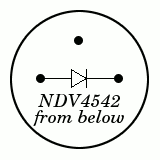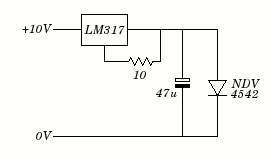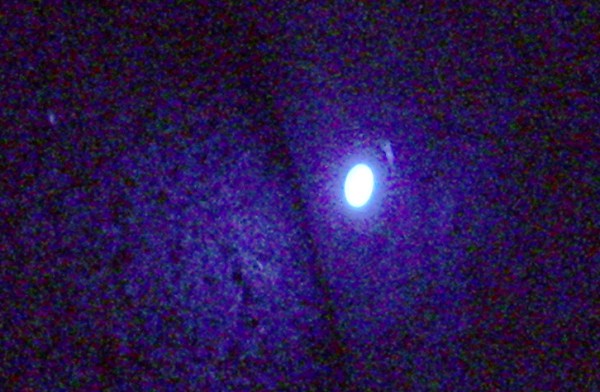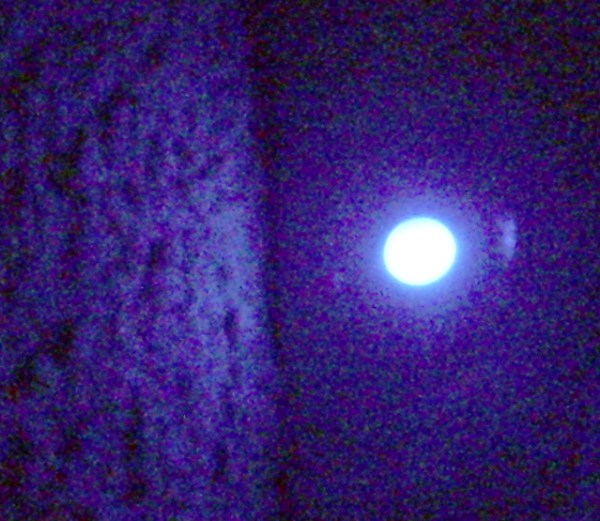
Nichia NDV4542 405nm 100mW
laser diode pinout diagram
(No, it's NOT a 200mW diode, whatever they say)
The purpose of this page is to provide useful information to anyone interested in fucking around with a Nichia NDV4542 405nm 100mW laser diode.

The first point concerns the pinout. Datasheets for this diode seem to be unfeasibly difficult to find. There is a photo of a datasheet floating around the net, but that seems to be the best there is; the actual document does not seem to be anywhere, which is shit. It is particularly shit because the photo is too small and blurred to read the bloody pin numbers, so the natural response is to search for a better diagram on which they are readable; this does provide quite a few results, but they are all the WRONG BLOODY WAY ROUND. I initially connected up my specimen according to those diagrams, and it didn't work. Fortunately (thank you Lord) I got away without blowing it up, and when I reversed the connections it sprang to life. Phew. The CORRECT pinout is shown in the diagram on the right.

The next point concerns the power rating. The NDV4542 is a 100mw laser diode, but a lot of people on the net are mendaciously flogging it as a 200mW diode. It is true that the datasheet photo quotes this as an absolute maximum, but this does not mean that you can get away with running it at 200mW output indefinitely and expect it not to blow up (and indeed I did come across one reference from someone who had tried this and did blow it up). So take note of the second table, which quotes 100mW continuous output, and operate it at a maximum current of 130mA. A circuit to run it at 125mA is shown on the right. If you want more power then buy a different diode.
To test my diode I clamped it between two scraps of aluminium sheet, one with a 2.5mm hole for the front of the can to poke through, and one with a 3.5mm hole for the wires. Heatsink goo was applied around the 2.5mm hole to assure good thermal contact. This provides enough heatsinking to run it for a few minutes to see what it can do, but it does get pretty warm and I wouldn't leave it running like that. Since I had only got the thing that morning I hadn't assembled anything better; I just wanted to make sure it worked and see what the beam was like. I now have it mounted in a pukka holder from Odic Force.
Two photos of my crude what-does-it-do setup are shown below. On the left is the laser diode in its temporary bits-of-aluminium mount, and immediately in front of it is a 15x eyeglass which I had lying about. This is not precisely aligned; it is just balanced on the floor at its natural angle, which happens to be close enough for this test. On the right is a piece of paper which fluoresces blue where the beam strikes it. The second photo is taken with a much shorter exposure to give a better view of the beam spot. It is a remarkably good circle despite the crudity and poor alignment of the optics and the asymmetry quoted for the raw beam, which I found most gratifying since it means I won't have to fuck about with complicated expensive optics to get a nice round spot, unlike other laser diodes I have fucked around with. Even the eyeglass is capable of focussing it down to a concentrated enough spot to burn black tape or paper, and it also hurts to put my hand in it for more than a few seconds; never mind eye-safe, this laser isn't even hand-safe. I don't actually intend to use it for burning things, though; I have other lasers for that which are both cheaper and more powerful.
Since then I have mounted it in a cylindrical chrome-plated brass holder with an adjustable 3-element glass lens AR-coated for 405nm. The diode is supposed to be a press fit into a little well inside the holder; unfortunately the well was not very well machined, and while it is a press fit around the lip of the well, the diameter of the well increases inside and the diode is a bit loose and wobbly when fully inserted. I managed to hold it more firmly in place by means of a combination of a spring and various washers and spacers I had lying around, compressed between the back of the diode and the inside of the back of the housing. The housing is then mounted in a clamp which is bolted to a heatsink out of a dud monitor; the heatsink also carries the LM317 and a bracket to attach the power supply wires. All interfaces between the diode and the heatsink are coated with heatsink goo, and the rough finish of the clamp was filed smooth on the bottom surface. The housing, lens and clamp were all supplied by Odic Force.
This setup gives a very good circular beam indeed; here are a couple of photos. The apparent distortion is a product of the angle they were taken at, and the "screen" not being exactly perpendicular to the beam axis (because it would fall over if it was; it is only an old envelope standing more or less on edge).


Finally I took the whole lot apart again and installed the laser diode inside my spare eyeball, so that I can do this:
...What that really is is the result of focussing the beam down to a much smaller spot while aimed at the same old-envelope screen, so it has burnt a hole through the front layer of the envelope and is reflecting off the inside.
The beam is not visible in clean air, but shows up nicely if I have a good chug on a fag and blow the smoke into the general area, even after the noticeable cloud has dispersed. I tried to get some photos of this but the shitty digital camera failed to pick it up, so we're out of luck there.
So by way of conclusion, then, if you are doing something which requires (a) 405nm wavelength, (b) maximum power 100mW, and (c) a high quality beam that can be easily focussed to a circular spot, this diode appears to be a good choice.
Update: I have been informed by someone who contacted Nichia asking for details of this laser diode that it is not actually a Nichia product. Apparently it is some other buggers using Nichia's name. I suppose that explains the lack of decent datasheets. Still, it doesn't matter.
Back to Pigeon's Nest
Be kind to pigeons